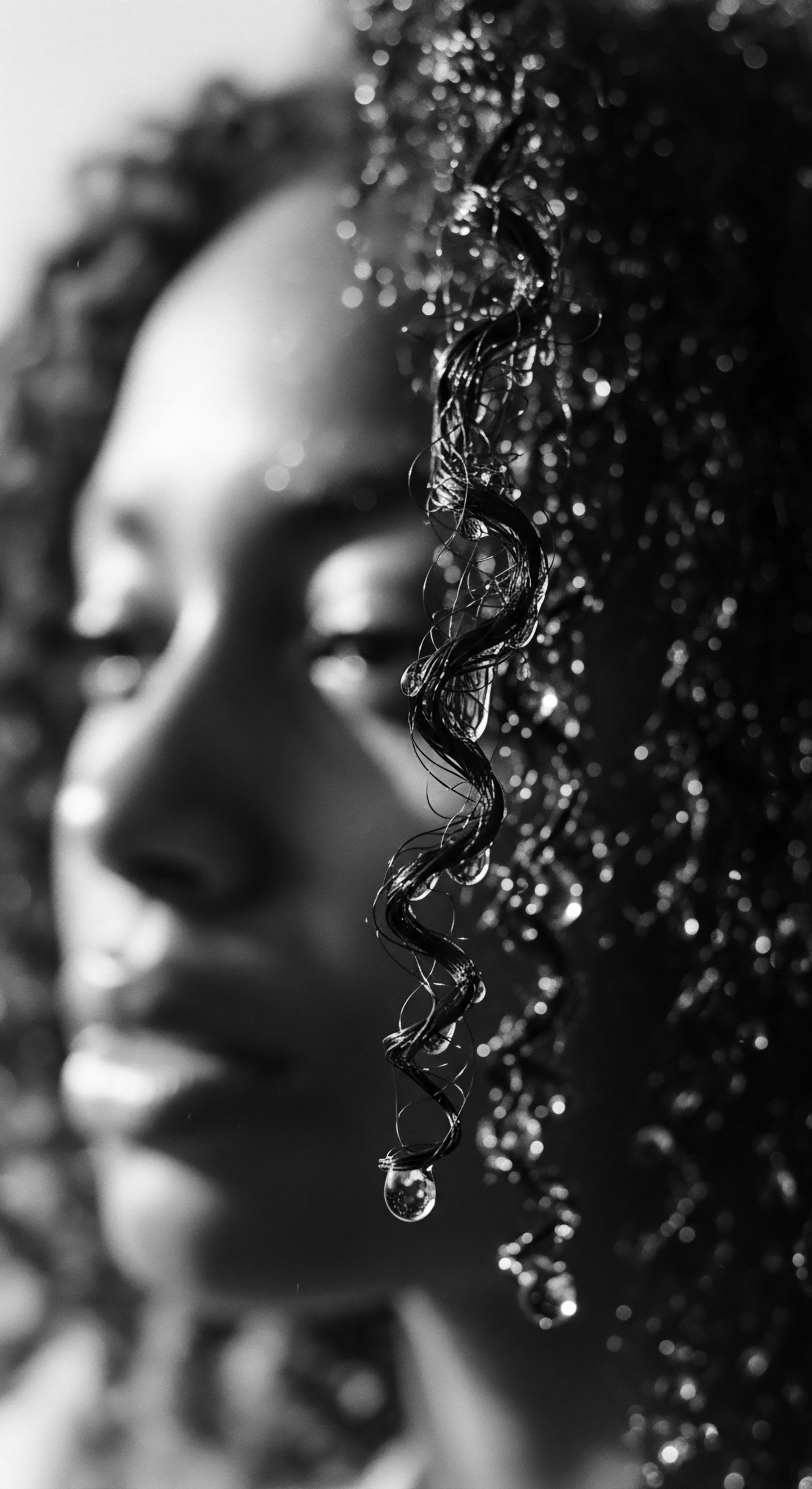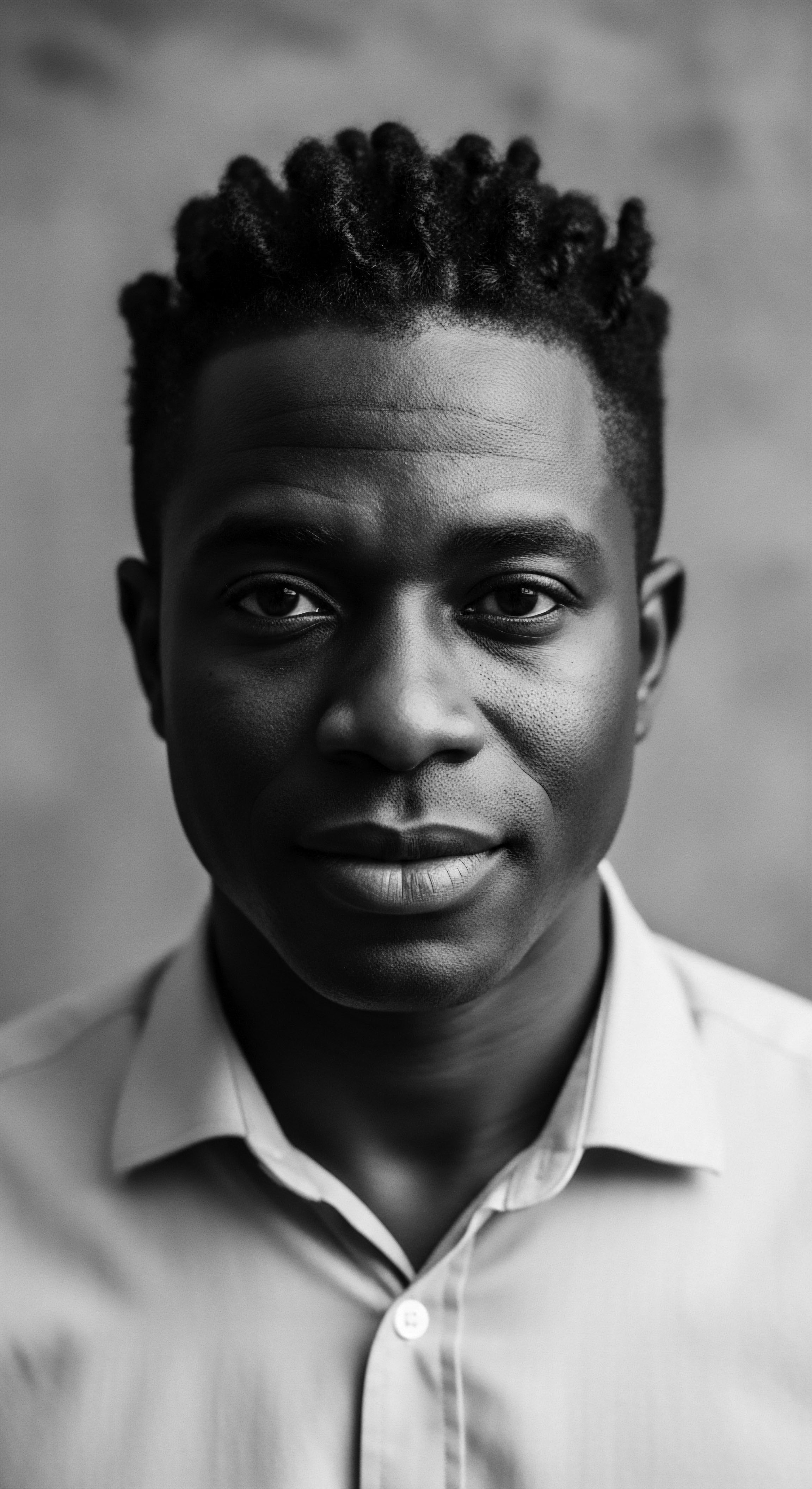
Fundamentals
The concept of Clay Cleansing History unveils a profound lineage of natural hair care, stretching back to the earliest human settlements. It speaks to the ancestral wisdom that recognized the earth’s bounty as a source of purity and restoration for textured hair. At its simplest, the meaning of Clay Cleansing History involves understanding how various mineral-rich earths have been employed across civilizations to purify, nourish, and care for hair and scalp.
This practice extends beyond mere hygiene; it embodies a holistic approach to well-being, where external cleansing connects intimately with internal balance and spiritual grounding. The delineation of this history requires us to examine how communities, particularly those with textured hair, inherently understood the unique properties of clays long before modern science could offer its explanations.

Origins and Early Applications
From ancient Mesopotamia to the fertile Nile Valley, archaeological records and historical accounts describe the early integration of clays into daily grooming rituals. These civilizations, deeply attuned to their natural surroundings, observed how certain earths interacted with water, creating a slippery, absorbent paste capable of drawing out impurities. The inhabitants of ancient Egypt, for example, were known to use mixtures involving clay not only for skin but also for hair, suggesting an understanding of its cleansing attributes.
The Clay Cleansing History, at its essence, illustrates humanity’s age-old reliance on mineral earths for textured hair purification and wellness.
The earliest documented uses often reveal clay as a fundamental component for maintaining hair health, providing a gentle alternative to harsher agents. This initial, straightforward understanding of clay’s utility laid the groundwork for more complex applications in subsequent eras.

Elemental Properties and Gentle Care
Clays possess specific mineral compositions that allow them to absorb excess oils, dirt, and product buildup without stripping the hair of its vital moisture. This distinctive action sets them apart from conventional detergents. Various types of clay, such as bentonite and kaolin, each carry unique mineral profiles and absorptive capacities, influencing their suitability for different hair types and cleansing needs. Bentonite clay, for instance, forms from volcanic ash deposits and is celebrated for its remarkable ability to draw out negatively charged toxins.
Kaolin clay, often softer, is valued for its gentle cleansing and soothing properties, particularly for sensitive scalps. This inherent gentleness made clays an ideal choice for hair that naturally tended towards dryness or required careful handling, qualities often seen in textured hair strands.
The foundational concept of Clay Cleansing History, then, is rooted in the elemental biology of these earths and their capacity to interact harmoniously with the body’s natural systems. This knowledge was observational and experiential, passed down through generations. These early practitioners recognized the clays’ capacity to cleanse, condition, and even strengthen hair fibers, fostering environments where hair could truly thrive.

Intermediate
Moving beyond the simple understanding, the intermediate definition of Clay Cleansing History explores its deeper cultural significance and the evolution of its application, particularly within communities with textured hair. This historical journey reveals clay cleansing as more than a physical act; it became a cherished tradition, a component of beauty rituals, and a silent expression of identity, especially when other forms of cultural expression were suppressed.

The Living Traditions of Care and Community
Across North Africa and sub-Saharan regions, various indigenous communities, including Berber women, the Himba, and the Maasai, integrated clays into elaborate hair care regimens. These practices often involved mixing clays like Rhassoul with water, plant extracts, or even animal fats to create nourishing pastes. Rhassoul clay, specifically, has a documented history of use dating back centuries in Moroccan traditions, serving not only as a cleanser but also as a conditioner, prized for its ability to purify without drying.
Clay Cleansing History illustrates how these practices were not merely functional but were deeply embedded in community life, often serving as moments of shared care and storytelling.
The women of the Himba tribe in Namibia offer a poignant example of this deep connection. They traditionally coat their hair in an ‘otjize’ mixture, a distinctive reddish paste made from ground ochre, butterfat, and sometimes aromatic resins or herbs. This practice serves multiple purposes ❉ it cleanses the hair, provides sun protection, detangles the strands, and importantly, acts as a powerful cultural marker. This unique application for textured hair, handed down from mother to daughter, is part of a morning ritual that symbolizes courage, status, and a profound connection to their land and lineage.
| Clay Type (Regional Origin) Rhassoul (Morocco) |
| Common Traditional Additions Water, argan oil, essential oils, herbs (e.g. lavender, chamomile) |
| Significance to Textured Hair Heritage Offers gentle purification and conditioning, preserving natural moisture, a staple in North African beauty rituals handed down through generations. |
| Clay Type (Regional Origin) Bentonite (Various, historically Iran, India) |
| Common Traditional Additions Apple cider vinegar, water |
| Significance to Textured Hair Heritage Known for its drawing properties, historically used for deep cleansing and detoxification of scalp, particularly beneficial for removing buildup on coiled strands. |
| Clay Type (Regional Origin) Kaolin (China, but globally present) |
| Common Traditional Additions Water, plant extracts, oils |
| Significance to Textured Hair Heritage A milder clay, often chosen for sensitive scalps and delicate textured hair, providing gentle cleansing without stripping. |
| Clay Type (Regional Origin) Ochre/Red Clay (Various, notably Himba Tribe, Namibia) |
| Common Traditional Additions Butterfat, aromatic resins, herbs |
| Significance to Textured Hair Heritage Beyond cleansing, provides sun protection, detangling, and serves as a powerful cultural identity marker and aesthetic statement for highly textured hair. |
| Clay Type (Regional Origin) These varied clays, each with unique properties, reflect diverse ancestral understandings of how natural elements support hair health and cultural expression. |

From Sustenance to Adornment
The significance of clay cleansing extends to the understanding that hair itself holds a powerful symbolic value within these societies. Hair was not simply biological; it served as a living canvas to signify marital status, age, wealth, and tribal identity. The application of clay became interwoven with these social and spiritual expressions.
The process of preparing and applying clay often involved communal gatherings, reinforcing social bonds and transferring knowledge through observation and participation. This communal aspect highlights how clay cleansing was a ritual, a tender thread connecting individuals to their lineage and community.
The continuity of these practices, even through periods of immense disruption such as the transatlantic slave trade, speaks volumes. While many African cultural traditions were forcibly suppressed, the resilience of hair practices, sometimes adapted with available resources, demonstrates a quiet resistance and the enduring power of self-expression. The use of natural materials like clay, though perhaps modified, continued to offer a means of care and connection to ancestral ways, even in the face of dehumanization. These moments of hair care became acts of reclamation, a subtle yet profound assertion of identity.
Thus, the intermediate lens of Clay Cleansing History reveals a practice that is deeply human, interwoven with social structures, cultural meanings, and the preservation of heritage against challenging backdrops.

Academic
An academic interpretation of Clay Cleansing History necessitates a rigorous exploration of its scientific underpinnings, cross-cultural comparative analyses, and its profound implications for understanding textured hair within a heritage framework. This perspective moves beyond descriptive accounts to critically examine the mechanisms, adaptations, and long-term socio-cultural consequences of clay’s historical use as a cleansing agent.

Defining Clay Cleansing History ❉ A Geospatial and Cosmetological Nexus
Clay Cleansing History can be academically defined as the comprehensive interdisciplinary study of the historical, ethnobotanical, and physiochemical applications of various hydrous phyllosilicate minerals (clays) for the purification, conditioning, and aesthetic modification of human hair, with particular emphasis on textured hair morphologies and their associated ancestral and diasporic cultural practices. This definition underscores the convergence of geological science, human cultural anthropology, and cosmetology, revealing how the earth’s mineral resources have shaped and been shaped by human hair care traditions over millennia.
The academic lens scrutinizes the precise mineralogical composition of different clays—such as montmorillonite (bentonite), kaolinite (kaolin), and stevensite (Rhassoul)—and correlates these with their historically observed efficacy. For instance, the high cation exchange capacity of smectite clays, including bentonite and Rhassoul, provides a scientific explanation for their renowned ability to adsorb excess sebum, impurities, and positively charged toxins without causing excessive desiccation of the hair shaft. This molecular interaction, long understood empirically by ancestral practitioners, offers a validated mechanism for their cleansing action. Conversely, the lower cation exchange capacity and larger particle size of kaolin clay contribute to its gentler nature, making it suitable for more delicate hair types and sensitive scalps, a characteristic consistently noted in traditional applications.

Deep Analysis ❉ The Himba Otjize and Afro-Textured Hair Resilience
A specific historical example powerfully illuminates the Clay Cleansing History’s connection to textured hair heritage and ancestral practices ❉ the Otjize of the Himba people of Namibia. This distinctive red clay mixture, applied extensively to the hair and body, represents a complex interplay of environmental adaptation, cultural identity, and physiological hair care. The Himba’s traditional use of otjize, primarily composed of ochre pigment, butterfat, and often aromatic herbs like Omuzumba, serves not only as a cleansing and conditioning agent but also as a powerful symbol of their ethnic identity, marital status, and spiritual connection to their lineage.
From an academic standpoint, the otjize functions as a multi-functional cosmetic. The clay component mechanically cleanses by binding to dirt and excess sebum, which is then removed. The butterfat, typically from cow’s milk, provides an occlusive layer, sealing in moisture and protecting the hair from the harsh, arid climate of Namibia. This protective barrier is particularly relevant for highly textured hair, which is prone to dryness and breakage due to its structural characteristics, including more numerous cuticle layers and a greater surface area relative to its mass (Rolls, 2017, p.
89). The butterfat also provides slip, aiding in detangling and minimizing mechanical stress during styling. The reddish ochre pigment, beyond its aesthetic appeal, may offer a degree of natural UV protection, safeguarding the hair and scalp from sun damage—a pragmatic adaptation in their environment.
The longevity of this practice underscores its effectiveness. Himba women maintain incredibly long, well-preserved hair, defying notions that textured hair is inherently fragile or difficult to grow. This stands as compelling empirical evidence of traditional clay-based care supporting hair integrity over a lifetime.
The ritualized application, often performed communally, also reinforces social cohesion and intergenerational knowledge transfer, representing a living archive of hair care ethnobotany and cultural resilience. This continuous lineage, spanning centuries, directly counters historical efforts to devalue and disassociate Black and mixed-race hair from its African origins, particularly during periods of enslavement and colonial suppression where such practices were often forbidden or denigrated.

Global Echoes and Contemporary Relevance
The academic perspective further contextualizes clay cleansing within a global historical narrative. Ancient civilizations such as those in Mesopotamia and Egypt utilized clay mixtures for hair and body care, demonstrating a widespread, independent discovery of these materials’ properties. The Rhassoul clay, for example, mined from the Atlas Mountains in Morocco, has been a cornerstone of Moroccan Hammam rituals for over 1400 years, prized for its cleansing and conditioning properties. This global prevalence suggests a universal recognition of clay’s benefits, often predating modern scientific frameworks.
The re-emergence of clay cleansing in contemporary natural hair movements, particularly within the Black diaspora, signifies a conscious return to ancestral practices. This revival is often driven by a desire for products free from harsh chemicals and a reclaiming of hair care traditions that honor textured hair’s unique needs. Modern scientific inquiry now validates many of these long-held traditional understandings, offering a bridge between ancient wisdom and current cosmetological science. This ongoing dialogue underscores the profound and enduring significance of Clay Cleansing History, not as a static historical artifact, but as a dynamic, evolving practice deeply intertwined with identity, cultural heritage, and the pursuit of holistic well-being for textured hair.
Academically, this continuous thread from ancient rituals to contemporary practices presents a valuable area of study for dermatologists and hair scientists. A significant observation for instance, is the apparent scarcity of extensive formal research on the efficacy of clays like Rhassoul when incorporated into cosmetic hair products, despite centuries of traditional use. This disparity between anecdotal historical evidence and contemporary scientific validation offers a rich pathway for future research, urging a more comprehensive scientific exploration of ancestral hair care solutions. Such studies could systematically analyze the long-term benefits of clay cleansing for scalp health, hair fiber integrity, and overall hair wellness across diverse textured hair types, drawing inspiration from the very traditions that preserved this knowledge over countless generations.
- Himba Otjize ❉ A ritualistic clay and butterfat mixture used for cleansing, protection, and cultural identity.
- Rhassoul Clay ❉ A Moroccan mineral clay with centuries of use in North African hair and body rituals.
- Bentonite Clay ❉ Volcanic ash-derived clay, historically applied for its detoxifying and absorbent qualities.
- Kaolin Clay ❉ A gentle, mild clay known for soothing the scalp and cleansing without stripping natural oils.

Reflection on the Heritage of Clay Cleansing History
The journey through the Clay Cleansing History, from its earliest elemental whispers to its resonant contemporary echoes, reveals a story much deeper than mere hygiene. It is a profound meditation on the enduring relationship between humanity and the earth, particularly as it pertains to the intimate care of textured hair. We perceive this history not as a collection of isolated facts, but as a living, breathing archive, where each clump of clay, each handed-down recipe, each communal hair-braiding session holds a fragment of ancestral wisdom. The meaning embedded in these practices speaks of an intuitive understanding that predates modern laboratories, a sense of holistic connection to the natural world that shaped not just how hair was cleaned, but how identity was expressed and preserved.
The tender thread of clay cleansing, stretching from ancient North African rituals to the Himba’s vibrant otjize, speaks to the resilient spirit of communities who, through their hair, declared their enduring presence and power. It reminds us that our hair is never simply a collection of strands; it is a repository of memory, a symbol of resistance, and a celebration of enduring beauty. As we consider the future of textured hair care, the lessons from Clay Cleansing History gently guide us toward practices that honor this profound heritage.
They prompt us to seek balance, to listen to the whispers of ancient soils, and to acknowledge the unbroken lineage of care that has always seen our hair as a sacred extension of self. The unbound helix of our future, then, is not one that abandons the past, but one that braids it tightly with contemporary knowledge, ensuring that the soul of every strand continues to tell its magnificent, rooted story.

References
- Rolls, A. (2017). African Hairstyles ❉ Hair Art and Cultural Identity. University of KwaZulu-Natal Press.
- The Legacy of Lathers ❉ Tracing the Historical Use of Natural Ingredients in Hair Cleansing. (2023, November 16).
- The Scenario of Clays and Clay Minerals Use in Cosmetics/Dermocosmetics – MDPI.
- The History of Hair Clay- A Timeless Styling Tool – Bingo Cosmetic Manufacture Ltd. (2024, May 31).
- Ghassoul ❉ history, benefits and uses – Ecosystem Laboratoire. (2024, July 12).
- Are We Losing Our Black Hair Care Recipes? (2024, October 11).
- Bentonite Clay for Hair ❉ Benefits, How to Use, Mask Recipe – Healthline. (2018, March 29).
- Clay for skin ❉ discover the secrets of the best clay masks – Nutritive Cosmetics. (2023, October 9).
- 6 Amazing Bentonite Clay Hair Benefits & How To Use It – HeyCurls. (2021, September 1).
- Bentonite Clay as a Natural Remedy ❉ A Brief Review – PMC – PubMed Central.
- The Magical Bentonite Clay Mask For Soft And Bouncy Hair – Sonderbeaut. (2024, February 25).
- The Power of Hair Across Cultures ❉ A Symbol of Identity and Expression. (2024, August 19).
- Rhassoul (ghassoul) clay – Humblebee & Me. (2019, March 5).
- Bentonite Clay for Natural Hair is Trending – L’Oréal Paris. (2020, April 3).
- Hair in Ancient Civilizations ❉ From Mesopotamia to Rome – Bebrų Kosmetika. (2025, May 20).
- Uses for Kaolin Clay – The Yellow Bird. (2019, August 22).
- A Crowning Glory ❉ Hair as History, Identity, and Ritual | Khumbula. (2024, April 16).
- Rhassoul ❉ a ritual for hair and skin care to purify and relax body and soul. (2024, January 22).
- How did black people do their hair in Africa before slavery began? – Quora. (2017, June 22).
- Ghassoul (Rhassoul) Clay ❉ Origin & History Of This Amazing Wonder!
- Rhassoul – Wikipedia.
- What are the benefits of rhassoul clay? – BIOVIE.
- White kaolin clay ❉ its beauty benefits – Argile du Velay.
- The Rich History of Dreadlocks in Black Culture – TSPA Battle Creek. (2025, February 19).
- Moroccan Rhassoul Clay – More Than a Magical Face Mask! – Indagare Natural Beauty. (2018, February 23).
- Nourishing Kaolin Clay & Coconut Shampoo Bar – Ecosattva.
- The Ancient Natural Ways of Hair Care Across Continents – 22 Ayur.
- Introducing the types of kaolin clay +The purchase price – Arad Branding.
- The Real Science Behind African Black Soap Shampoo for Hair Growth. (2025, May 13).
- Kaolin Clay Benefits, Uses and Side Effects – Dr. Axe. (2025, February 21).
- Getting To The Root of Hair Cleansing – natureofthings.
- Rhassoul clay – Helenatur. (2020, March 5).
- Black natural hair movement ❉ How it thrived on social media | Yes Gurl.
- Natural Hair ❉ A Quick History Lesson – LivSo. (2020, July 19).
- Rhassoul Clay – Agape Wholistic Therapy. (2020, October 29).
- Ancient Egypt’s Most Indulgent Beauty Secrets – TheCollector. (2022, January 16).
- Historical Roots of Makai Hairstyle of Elmina People of Ghana – International Journal of Arts and Social Science.
- The evolution of textured hair care and styling, a brief history – The Diamondback. (2022, May 22).
- Hair Cosmetics ❉ An Overview – PMC.
- Narratives of Black Women on Hair in the Workplace.
- No raw oils and butters vs. Traditional African hair care? ❉ r/Naturalhair – Reddit. (2021, August 26).
- Aztec Clay Hair Mask ❉ Benefits & How to Use It Step-By-Step – Curl Centric. (2023, February 26).
- Is this the Original Clay Hair Mask?| Hair History in Africa – YouTube. (2022, June 20).
- The Value of Indigenous Hair-care and Knowledge | ZedHair. (2012, March 14).
- I Tried a 4,000-Year-Old Egyptian Hair Mask—Here’s What Happened – YouTube. (2025, May 23).
- Why Africans Put Clay on Their Hair | TikTok. (2025, June 9).
- What Every Dermatologist Must Know About the History of Black Hair. (2023, November 30).
- ART, SCIENCE AND TECHNOLOGY IN PRE-COLONIAL GHANA. (2025, January 10).
